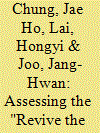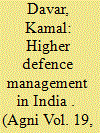| Srl | Item |
| 1 |
ID:
089394


|
|
|
|
|
| Publication |
2009.
|
| Summary/Abstract |
This article, focusing on the "revive the northeast" programme, examines four questions: why was the northeast region selected as yet another macro-site for Beijing-endorsed scheme of regional development; how does it differ from the "develop the west" scheme; what does the "revive the northeast" scheme entail in concrete policy terms; and how can we assess the impact of this scheme on the region's economic development? While it offers a relatively positive assessment of the programme's impact in facilitating a faster growth during 2004-06, future challenges are also noted for a sustainable development of the northeast region as a whole.
|
|
|
|
|
|
|
|
|
|
|
|
|
|
|
|
| 2 |
ID:
147276


|
|
|
| 3 |
ID:
119624


|
|
|
| 4 |
ID:
169111


|
|
|
|
|
| Summary/Abstract |
This paper describes the current level of human capital in China and seeks to identify a number of education-related challenges that may slow down the nation’s economy from transitioning to high-income status. Relying on recent census-based data from OECD for the rest of the world and using data from the 2015 Micro-Census for China, the authors show that the low levels of education of China’s labour force is really a problem that has its roots in the past (in the 1970s, 1980s, and 1990s). In recent years (since 2000), China has been investing heavily in education as shown by the increasing the share of youth, including rural youth, attending high school. Despite this recent effort to raise the nation’s human capital, the education system still faces several challenges in trying to provide high-quality education for all youth. First, the government must figure out a way to overcome the relatively low rates of participation in high school by rural students. Second, there is concern that many vocational schools, especially those in rural areas, cannot deliver quality education. Finally, the paper will show that many rural students may be unprepared due to poor early childhood development outcomes.
|
|
|
|
|
|
|
|
|
|
|
|
|
|
|
|
| 5 |
ID:
122550


|
|
|
|
|
| Publication |
2012.
|
| Summary/Abstract |
In October 2006 General Charles Wald, Deputy Commander U.S. European Command, brought "Phase Zero" into the joint lexicon with the publication of an
article, "The Phase Zero Campaign."1
Over the last five years the concept of taking
coordinated action in peacetime to affect the strategic environment has become
widely accepted and is now integrated into theater campaign plans. These activities focus on building capacity of partners and influencing potential adversaries
to avoid war. In contrast, Chinese strategic culture has encouraged taking actions
to defeat an enemy prior to the onset of hostilities for two and a half millennia.
This accounts, in part, for the manner in which the People's Republic of China
(PRC) applies the elements of national power in the steady-state environment to
advance its strategic interests. While the United States remains focused on preparing the environment and building partners, Chinese strategic culture states a
preference for defeating an adversary before what Western thought thinks of as
war has begun. This outlook ultimately places the PRC in a position of strategic
advantage. To meet future challenges like that posed by the PRC, the United
States should better integrate Phase Zero with contingency (crisis) planning, then
design and execute operations in the steady-state environment that go beyond
avoiding war and attempt to settle conflicts in accordance with the national interests of the United States.
|
|
|
|
|
|
|
|
|
|
|
|
|
|
|
|
| 6 |
ID:
149534


|
|
|
|
|
| Summary/Abstract |
The Arbitral Tribunal’s award of 12 July 2016 was overwhelmingly in favour of the Philippines and denounced by China. Although the Republic of China (ROC, or Taiwan) was not a party to the arbitration, it was dragged into the proceedings, as the issue of the status and entitlements of Itu Aba — the largest geographical feature in the Spratly Islands, occupied by Taiwan and also known as Taiping Island — gained prominence in the course of the Tribunal’s deliberations.
|
|
|
|
|
|
|
|
|
|
|
|
|
|
|
|
| 7 |
ID:
138432


|
|
|
|
|
| Summary/Abstract |
The changing character of war places increased emphasis on ‘smart power’ and non-lethal ‘soft’ effects. Establishing useful and accurate measures of effectiveness through which to assess the impact of such activities is essential, but these have so far proven elusive. Neil Verrall argues that now is the time for militaries to start thinking differently about the evaluation of full-spectrum effects within the Joint Action approach.
|
|
|
|
|
|
|
|
|
|
|
|
|
|
|
|